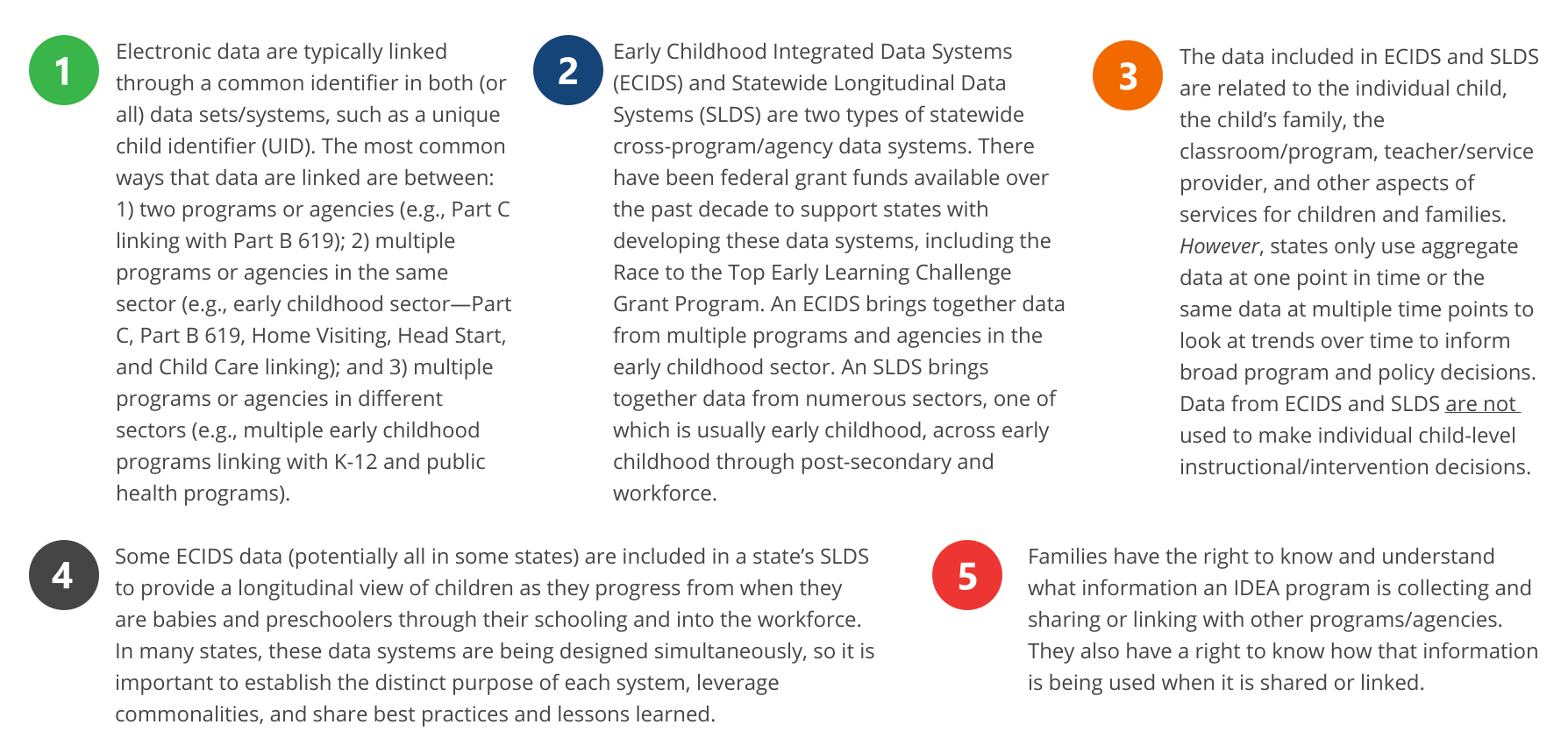
The process of joining or connecting records in one data set/system with those in another data set/system is called a data linkage. States have been working to link data across multiple programs or agencies so they can answer important questions about outcomes for children and families (e.g., Do children who receive early intervention improve enough so they do not need special education services later?). Some states are linking some type of IDEA data to other state program data (e.g., K–12) through in the creation of an Early Childhood Integrated Data System (ECIDS) and/or a Statewide Longitudinal Data System (SLDS) (to be described more fully in this section).
In this section, you will learn about:
- what ECIDS and SLDS are and the types of data they may include;
- the benefits IDEA programs can experience by participating in cross-program/agency data linkage initiatives; and
- tools/resources for systems-level stakeholders to support their involvement in conversations about data linkages.
What do I need to know?
Download a PDF version of this section.

How do I apply this to my state?
Forty-seven states, the District of Columbia, Puerto Rico, the Virgin Islands, and American Samoa have received at least one SLDS grant. Remember, some or all ECIDS data (i.e., data from programs that serve young children and their families) will be included in an SLDS.
- Find out if your state is or has been an SLDS grantee on the GRADS360 website by choosing your state from the dropdown.
- If your state has received a grant (or grants):
- Review the project abstract(s) to learn about what the state wants to accomplish as outlined in their grant application(s).
- If available/applicable, review the major outcomes for the grant award(s) period(s). Note: Some state’s grant periods are not over yet, so outcomes will not be reported.
- Ask your state lead agency partners about Part C‘s or Part B’s participation in the statewide linked data system work. For example:
- What type of early childhood data are included in the SLDS? Which early childhood programs are represented?
- What is Part C’s and/or Part B 619’s involvement in an ECIDS or SLDS? For example, what data are Part C and/or Part B 619 contributing?
- What data or information do Part C or Part B 619 get or hope to get from the system in return? What questions does the Part C or Part B 619 program want to answer with these data?
- If the state does not currently have an SLDS grant, but had one or more in the past, what’s being done to sustain cross-program/agency data linkage efforts?
- Regardless of whether your state is working on an ECIDS or SLDS , talk with your Part C or Part B state lead agency staff about any other program-to-program data linking initiatives planned or already active in the state (e.g., linkages between Part C and Part B; linking between Part C and Early Hearing Detection and Intervention (EHDI), etc.) and the outcomes of those efforts.
What are some related resources?
- Answering Key Questions with an Early Childhood Data System (National Center for Education Statistics, SLDS Grant Program). This document provides examples of policy questions from states and outlines why those questions are needed, how to create them, and who should be involved in the process.
- Informed & Ready: Questions Part C and Part B 619 Program Leaders Should Ask About an Early Childhood Integrated Data System. This DaSy Center brief describes the benefits for states participating in an ECIDS and explores some of the questions that Part C and Part B 619 leaders need to ask s part of deciding whether to contribute data to their state’s ECIDS.
- The Integration of Early Childhood Data: State Profiles and a Report from the U.S. Department of Health and Human Services and the U.S. Department of Education. This report is intended to help states refine their capacity to use existing administrative data from nearly childhood (EC) programs to improve services for young children and families.

